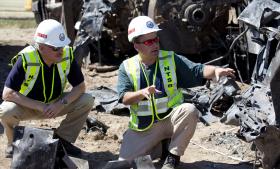Poor Eyesight Probable Cause Of Oklahoma Train Crash
By Brian Hardzinski and Associated Press

Federal officials say a train driver's failing eyesight was the probable cause of a fiery train crash that killed three people in the Oklahoma Panhandle last year.
Dr. Mary Pat McKay told the National Transportation Safety Board that the driver’s eyesight fluctuated from day to day and he couldn’t always distinguish red, green and yellow lights.
“This was a very bright, sunny clear day,” McKay says. “He may have had difficulty telling which of the lights were illuminated.”
McKay says if the railroad tested his vision in 2010, medical records show he would’ve failed acuity testing and failed any of the standard color vision tests.
“Systematically increasing frequency for deteriorating conditions instead of relying on a report would likely have prevented this collision,” McKay says.
Inspectors told the panel in Washington, D.C., Tuesday that an eastbound train passed signals ordering it to slow and stop so a westbound train could pass. The trains crashed June 24, 2012 near Goodwell at a combined speed of 79 mph.
“During the collision and derailment, several fuel tanks on the locomotives ruptured, releasing diesel fuel that ignited and burned,” NTSB investigator Jim Southworth says. “Damages [were] estimated at $14.8 million.”
The investigators said the crew of the eastbound train did not take action to stop until just before the fiery accident.
Human Performance Group Chairman Rick Narvel says the most challenging aspects of this investigation were the “unobtainable information.”
“There were no reported communications between the dispatcher, the crew of the eastbound train, or the train crews,” Narvel says. “No autopsies were able to be conducted.”
According to Narvel neither crew member of the eastbound Union Pacific Railroad train took action to stop the train until just seconds before the collision.
The NTSB voted 5-0 at the meeting to formally adopt the cause of the accident.
Investigators also proposed 16 new safety recommendations to curb future accidents. Those include more frequent medical exams for employees in safety-sensitive jobs and the development of a peer-to-peer program that encourages workplace safety.
http://kgou.org/post/poor-eyesight-probable-cause-oklahoma-train-crash

No comments:
Post a Comment